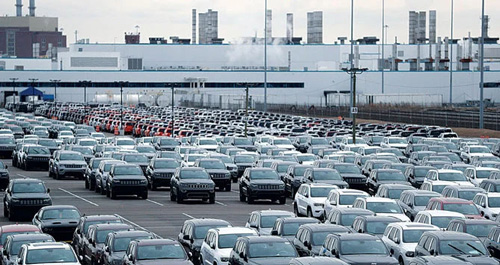Detroit
Defying a wave of layoffs that has sent the US job market into its worst catastrophe on record, at least one major industry is making a comeback: Tens of thousands of auto workers are returning to factories that have been shuttered since mid-March due to coronavirus fears.
Until now, it was mostly hair salons, restaurants, tattoo parlors and other small businesses reopening in some parts of the country. The auto industry is among the first major sectors of the economy to restart its engine.
About 133,000 US workers — just over half of the industry’s workforce before the pandemic — are expected to pour back into assembly plants that will open in the coming week, according to estimates. In addition, parts-making companies began cranking this week to get components flowing, adding thousands more workers.
Looming in the background is an economy decimated by the pandemic. Nearly 3 million laid-off US workers applied for unemployment benefits last week, raising the total seeking aid in the past two months to about 36 million. Although some states have begun to let selected businesses reopen, workers are still reporting difficulty getting unemployment benefits. Freelance, gig and self-employed workers are struggling.
Even the auto sector won’t see a full return to normal yet, and if people don’t start buying vehicles again, workers could be sent home. Yet automakers say there’s enough pent-up demand, especially for pickup trucks, to get factories humming again.
That could help states slow the drain on their unemployment benefit funds. In Michigan, where over one-third of the labor force sought benefits, the fund fell from $4.6 billion before the pandemic to $4.1 billion on April 30, said Jeff Donofrio, director of the state Department of Labor and Economic Opportunity. Some returning auto employees could work part-time and get still some unemployment benefits, but federal programs could cover part of their payments, he said.
At Ford, where about 47,000 US factory workers will return by next week, there’s optimism that consumer demand will accompany them. Chief Operating Officer Jim Farley said the company, using data collected from new Ford models from the past two years, is seeing sales recover.
In Europe, China and the US, Ford has found a correlation between the number of trips people take and auto sales, with trips increasing as restrictions eased.
“We started to see in early April a change where people started to take more trips,” Farley said Thursday. “The (sales) decline stopped and our retail sales improved a lot.”
Auto sales in China, where the virus peaked before the US, could be a harbinger of things to come. China sales fell just 2.6 percent in April from a year earlier, compared with a 48 percent free-fall in March. Production at many plants is nearly back to normal after being shut down in January and February. Volkswagen, Honda, Mercedes and Ford reported no virus cases among employees since reopening. —Arab News









